

CORRECTIONS:
















CORRECTIONS:













For many of us at the University of Arizona, it is buisness as usual with coming back to campus this fall for another great semester and year. But if you are new here on campus, welcome. I hope you have a great time as you start your college journey.
BY NATE STENCHEVER @DailyWildcatMy name is Nate Stenchever and I am happy to say I am this semester’s Editor-in-Chief of the Daily Wildcat . Our newsroom is back in full swing now so be on the lookout for our coverage on campus news and more.

No matter what year in school you’re in, if you’re interested in gaining new skills or professional experience for your resume, consider applying to the Daily Wildcat . We’re hiring reporters, opinion writers, photographers, and illustrators to be a part of university’s only student-run and editorially independant news source.
Our appllications are open right now, and can be found at wildcat.arizona.edu/jobs. If you have any questions, don’t hesitate to ask me by email at editor@ dailywildcat.com.
To stay in informed, keep an eye on our brand new website at wildcat.arizona.edu. Also make sure to look for us on social media @DailyWildcat on all our profiles, including Instagram, Threads, Twitter (X) and Facebook. Feel free to DM us or email us any time to provide feedback or let us know about any stories you think we should be covering.

Good luck with the rest of your semester.
Bear Down, Wildcats, Nate
StencheverFall 2023 Editor-in-Chief editor@dailywildcat.com

Ihope you all had a restorative summer and that you are looking forward to a thrilling new year. I am glad you are here, whether you are on campus for the first time, or returning, and I hope I have the chance to see you around campus or at one of the many incredible community events hosted at the University of Arizona. No matter what you have in mind for the future, the University of Arizona is 100% committed to supporting your Wildcat Journey. Here, you will receive handson training in your chosen field, learn from experts, make valuable connections with mentors, and gain all the skills you need for your future careers. Part of the Wildcat Journey is providing a safe, inclusive, and supportive community, which includes our recent efforts to enhance campus safety.
During the summer, we have been implementing
Sept. 29
The Arizona football team will play against NAU here in Arizona Stadium. Kick off is scheduled for 7 p.m. The last time the Wildcats played against the Lumberjacks, NAU beat Arizona 21-19.
Sept. 29 - Oct. 1
Every year, UA students invite their families to spend time with them toexperience what going to school here is like. Some activities include eating out, going to a football game, and introducing friends.
many new features and programs. Please visit safety. arizona.edu to learn about the latest initiatives and the Back-to-Campus Safety Checklist.
The University is an incredible place of learning, and we are deeply committed to your success. As students, you can find your place in our amazing, inclusive community. Above all, we want you to enjoy your time here, and to explore, learn, and treat each other with respect while you grow and pursue new ideas. I encourage you to take care of yourself, and to care for one another.
Welcome again, and Bear Down!
Robert C. Robbins, M.D .President — the University of Arizona
Sept. 29
Every year, the Arizona men’s basketball team starts the season with the Red-Blue game. This friendly scrimmage is where players debut the skills they’ve been working on. Tickets are on sale now.
Oct. 29
This is often a time for UA alumni to return to campus and reconnect with old friends. There will also be several activities (such as the Hoco football game) for both alumni and current students to enjoy.
Nov. 25
Duel in the Desert
The matchup between the Arizona and ASU football teams is one of the most anticipated games of the year. The rivalry between these schools goes back over 100 years. Last year, Arizona won 38-35.
Dec. 8-14
Finals week
This is when all courses will wrap up for the fall semester. There will be a variety of resources available for students to use to get through finals such as therapy dogs and free snacks.
Following the on-campus fatal shooting of professor Thomas Meixner last October, safety and security rose to the forefront of campus discourse at the University of Arizona and have compelled debates, leadership changes and calls for systemic transformation.
Initial issues
Following the October shooting, President Dr. Robert C. Robbins hired the PAX Group, a security consulting firm, to evaluate the UA’s campus safety and offer recommendations for improvement. After months of analysis and conversation with members of the campus community, the group released a report in March addressing the four main areas of crisis management in which the UA needs improvement: Threat Assessment Management, Crisis Response, the University of Arizona Police Department and overall communications.
In early February, before the PAX Group had finished its analysis of campus security, members of the University of Arizona General Faculty Committee on University Safety for All wrote and released an interim report that detailed the university’s response failures in light of the Oct. 5 shooting.
The report, titled “Oversight and Response Failure: Broken Trust. Lessons From the Events Surrounding the Murder of Professor Thomas Meixner,” addressed not just the lead up to the shooting and the university’s immediate response to it, but also the university’s handling
of harassment at the UA College of Law in 2019, the threats received by a Daily Wildcat reporter and an incident involving a queer, Black disabled student at the Martin Luther King Jr. building on campus.
This committee report concluded that there were four key areas in which the university failed.
Much like the PAX Group found a few months later, one of these systemic flaws was a failure to install an effective risk management system for risks of violence. The committee report noted that “the University does not have any office tasked with the responsibilities to detect, monitor, and address violence risks.
As a result, [the Dean of Students Office, Office of the General Council, Office of Institutional Equity] and UAPD employees do not have a clearly identified point of contact to report known violence risks.”
In an email sent to the student body in January, Robbins listed certain changes being made to enhance campus safety, some of which included the security assessment of university buildings, online preparedness training for students and faculty, the installation of “fire and safety compliant locks to classroom doors” and the expansion of background checks to include graduate assistants and associates.

A few prominent changes in leadership then took place in the aftermath of the PAX report’s publication, the first of which being Paula Balafas’ decision to step down as Chief of the University of Arizona Police Department. Balafas was replaced by Chris Olson, commander
of the Oro Valley Police Department’s field services division and a former UAPD officer.
[…]
In an email sent to students and faculty on March 27, Robbins announced that Steve Patterson, an FBI veteran, would be filling the role of interim chief safety officer, and would be responsible for “implementing the PAX Group’s recommendations and coordinating safety initiatives across the University” in addition to supervising the UA’s Threat Assessment Management Team. Another of the systemic issues the committee and PAX reports addressed was the inability of the TAMT to respond to the sheer scope of issues placed under its jurisdiction.
According to Patterson, many changes have been made to enhance the efficacy of TAMT since he began in a consulting role in November. The group has added multiple consultants to the team, including Gene Deisinger, president of Deisinger Consulting, LLC and Andrew Perkins, assistant professor of practice in the UA psychology department. The TAMT has also appointed a new director, Jessica Semmann, who will focus on education and engagement with the campus community as classes begin in the fall.
In addition to supervising the UA’s TAMT, Patterson also manages the Office of Public Safety, a newly established institution that is composed of the UAPD and TAMT.
The goal of this office, according to Patterson, is to coordinate safety efforts among many different groups at the UA who are
in some part responsible for campus security. Increasing awareness of campus happenings and communication between groups like Parking & Transportation Services, Facilities Management and the UAPD, Patterson hopes, will create a more efficient and unified approach to risk management and safety on campus.
Robbins also announced in March the formation of a Campus Safety Advisory Commission, made up of representatives from the campus community, to advise Patterson and other university leadership on how best to implement the recommendations from the PAX report.
[…]
Olson acknowledged that there are many people on campus who may not feel comfortable reporting directly to the UAPD and spoke to the power of support from faculty and staff on campus, as well as resources like Counseling and Psychiatric Services.
“Victim advocacy is a huge focus […] They don’t

have to work by themselves. There are people on this campus that will be advocates for them as they go through that process,” Olson said.
This emphasis on victim advocacy is conveyed through Olson’s work to establish a “victim advocate” position within the UAPD. The person in this role will support both victim and detective through the reporting process at the UAPD, according to Olson.
The university and UAPD have launched a variety of initiatives since last October that aim to rebuild trust in safety institutions and create a more secure, aware and involved campus environment.
In May, university leadership also announced the formation of a “mobile crisis team” and the creation of a new university safety website. The crisis team will provide support to students through the UA’s Counseling and Psychiatric Services, specifically in situations where UAPD is not the
entity best suited to resolve a situation or offer support. The new website, safety. arizona.edu, “includes in one central location actions plans, the university’s latest campus security updates and resources for students and employees,” according to UA News.
[…] Patterson hopes to continue conversations with the campus community and increase awareness among its members. A few years down the line, Patterson also hopes to see the UA be known nationwide as a preeminent university when it comes to safety and security measures.
As the school year progresses, members of the community can also expect more communication and updates coming from the Office of Public Safety, according to Patterson.
*Editor’s note: Portions of this article were cut for brevity. To read the full piece, go to wildcat.arizona.edu and search the title or author.
My name is Alyssa Sanchez. I use ella/ she/her pronouns and currently study political science with an interest in pursuing a career in immigration.
I have the honor and privilege of serving as the first ever Latina student body president of the Associated Students of the University of Arizona in history. This is an incredible achievement that I of my peers and myself have worked together to accomplish and I would like to express my gratitude in trusting me to represent your interests, concerns and, most importantly, your goals!

Being the student body president means being the voice and representation of the student body, and advocating for our needs and interests. At ASUA, we work to improve campus life and organize events, and my role specifically advocates for students in the rooms of faculty and administration.
As I am now approaching my final year, I have some words of advice for all those starting and/or continuing on their own educational journey at the UA.
When starting college, you’re introduced to the biggest challenge of all: figuring out who you are and what your purpose here is. These are questions that I still ask myself, and it’s okay to never fully know. I started out my academic career as a computer science major with a background in biomedical engineering. Now, I’m in a completely different field and life path altogether — and this is completely normal. With trying out different clubs, being a part of events and even joining a program, you never know where fate is going to take you. As long as you move forward in life with a positive outlook, you will find out a little more of who you are.
Our university offers endless opportunities to find community. ASUA is the student government and there’s many opportunities to become involved and seek leadership. If you’re curious, come to the office! We’re located on the third floor of the Student Union Memorial Center, and students are always welcomed!
Our resource centers include African American Student Affairs, Guerrero Student Center, Asian Pacific American Student Affairs, Disability Resource Center, Immigrant Student Resource Center, LGBTQ+ Affairs, Native American Student Affairs and the Women and Gender Resource Center and are located in different areas of our campus. These centers offer safe spaces and community for those with shared backgrounds and
experiences.
If you have your CatCard, there are so many free events the Wildcats Events Board throws throughout the school year and ZonaZoo always brings the energy and hype to our games!
The 50th anniversary of Spring Fling is this year and everyone here at ASUA is working our hardest to bring back one of the nation’s biggest student-run carnivals. We hope to see it again and are working hard to make this year special.
Nothing in life is done alone or done by one single person; everyone needs help and our university is filled with good people. Counseling & Psych Services is a great resource for mental health guidance. Our cultural resource centers
also offer embedded counselors who offer similar services with added cultural understanding. Always reach out to your advisors, they are here for you. Be curious, ask questions and form a study group. Don’t be afraid to reach out if you need help, because there’s so much strength in vulnerability.
Growing up in Tucson, I was surrounded by the beautiful landscape the desert and mountains provide. As you explore the greater Tucson area, you will notice beautiful local art that’s all around you. Try the local cuisines and food trucks; we have so many different options that offer delicious food with a welcoming and friendly environment. There are so many things to do here like visiting historical sights, mountain climbing and taking a million photos of our gorgeous sunsets. Just remember to always be respectful to those who live here yearround and always take care of our natural environment.
I want you all to know that at the University of Arizona you are starting a new chapter and you need to be kind to yourself. There will be times where you’re going to feel like you’ve lost yourself or you’ve messed up, but know that failure does not define who you are. Failure offers the opportunity for growth and understanding. You need to love yourself enough to give yourself space to grow and know when you can no longer do it alone. Always try to make you and your family or community proud. Lead with a good heart and understanding mindset, open yourself up to others and always know that you’ve always been good enough. Thank you for reading my introduction, and I wish everyone a wonderful year.
VIVA LOS GATOS!Student Body President 2023-24
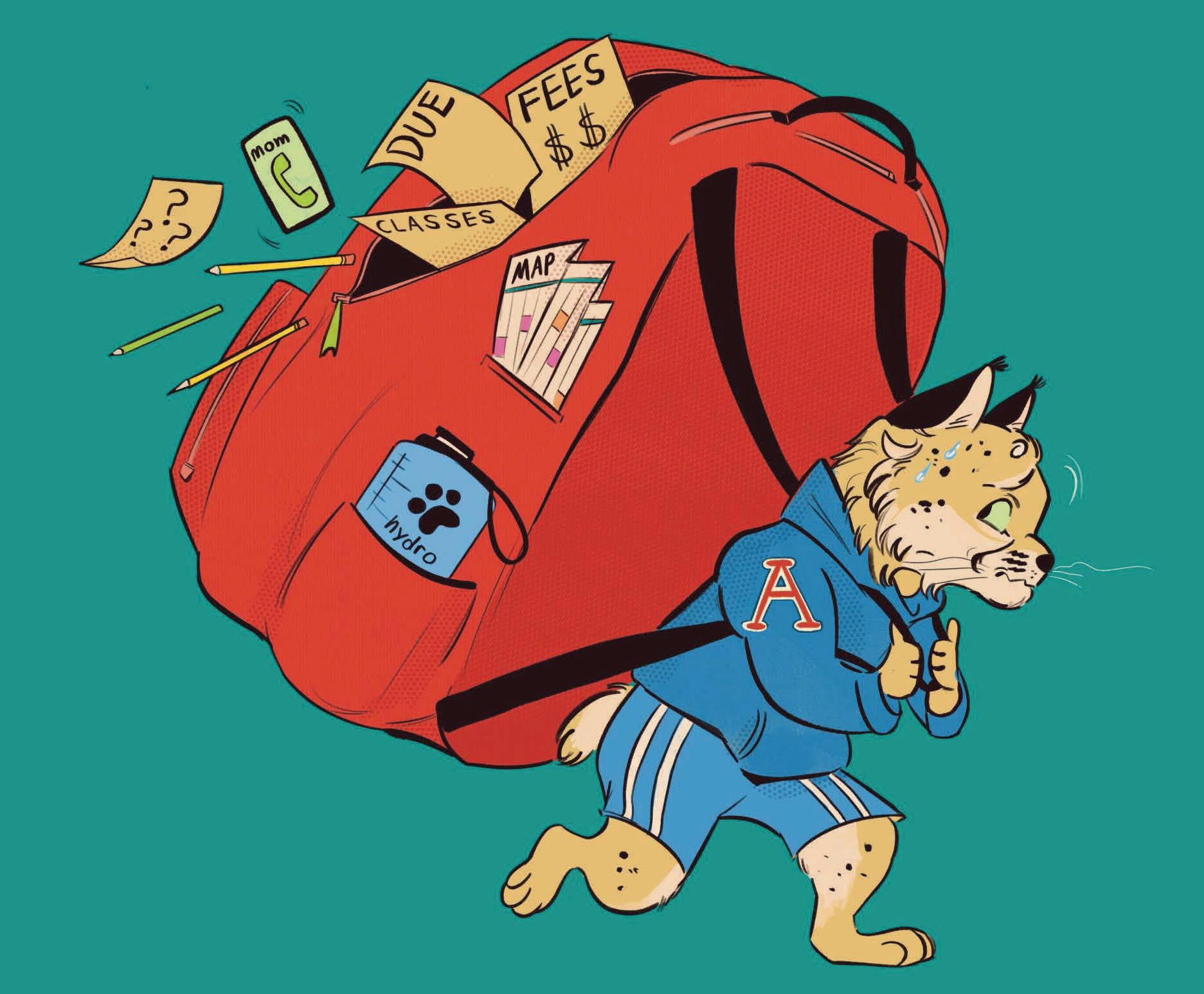 BY EMILEE CEUNINCK @DailyWildcat
BY EMILEE CEUNINCK @DailyWildcat
Freshman year of college is often accompanied by a wide array of emotions, ranging from excitement to terror — sometimes even simultaneously. Adjusting to an unfamiliar environment can be challenging, especially when new classes and responsibilities are thrown into the mix. Below, University of Arizona students and recent alumni share their best tips for having an incredible freshman year and coping with all the changes.
Miles Fraser is a sophomore majoring in creative writing. When it comes to starting college, he recommended being friendly with everyone to help form connections. But understand that it is fine to rely on family and other friends outside of the UA to cope with being away from home for the first time.
“Call your friends, call your parents, anyone; they want to talk to you,” Fraser said. “At a certain point, you’ll have friends in college that you’ll be able to have these conversations with, but until then, it’s okay to lean on people you’re comfortable with.”
Some must-visit attractions around Tucson that Fraser endorsed include hiking Mount Lemmon and Tucson’s Sentinel Peak, commonly known as “A” Mountain. A hidden gem he and his friends loved during their freshman year includes the Arizona hockey games accessible via the Sun Link streetcar. Located in the Tucson Convention Center, the first 200 CatCard holders get in free!
“Lots of energy and free for students even if you don’t have the pass. Just a great time all around,” Fraser said. His best study tip is to take advantage of the library and all the resources and activities advertised on bulletin boards. He suggests making an effort to attend events that are interesting. Looking back at his recently completed freshman year, Fraser wishes that he had taken advantage of the club fair at the start of the semester and joined more clubs.
“Don’t be nervous. At the University of Arizona, you have thousands of kids who are in your exact shoes, and even though it might not seem that way, it’s true,” Fraser said. “Make friends, talk to people in line in the Union, shoot your shot, don’t be shy.”
Olivia Brodersen recently graduated with a degree in molecular and cellular biology. Her top study tip is to ask all kinds of questions, no matter if they appear to be silly or dumb. She also recommends the Brightspace Pulse mobile app that is connected to D2L. Users can find due dates, check grades and set reminders with just one click. Brodersen also emphasized the importance of making connections during college.
“If I could do it all over again, I would knock on my neighbor’s doors and get to know them. I was the academic kid but grades and friendships do matter in college,” Brodersen said.
She also suggested finding others with similar interests to go on campus excursions and not being afraid to share favorite memories from home with new people to combat homesickness.
A must-do free activity all freshmen need to experience that Brodersen recommended is exploring campus for hidden sculptures, such as the unicorn sculpture in the School of Dance wellness garden and the small Han Solo frozen in carbonite found in the Sonoran Pentapus structure (large dome-like covering that resembles a piece of art and provides
shade) in between the Architecture building and Center for Creative Photography.
Brodersen’s guiding words for freshmen year were, “It is okay to not be okay.”
Kiersten Scarbrough is a junior studying elementary education and Spanish. In addition to joining clubs, she proposed taking advantage of on-campus events throughout the year, especially those hosted by individual colleges. Students can learn about these activities by checking their email or through advertising around campus. Events offer another way to meet new people.
One thing that Scarbrough utilized to make the transition to college easier that she wished she had known about sooner was the university peer mentor programs available.
“As soon as I joined one, I felt a lot better, and the transition was much easier,” Scarbrough said. “It’s a great way to meet new people as well.”

Scarbrough’s best tip for staying on top of academics is to develop good study habits immediately. Proactively getting assignments done early helps to alleviate stress and provides more free time. She is an advocate of the 45 minutes on and 15 minutes off rule for long study sessions, spending 45 minutes being productive and then having a 15-minute break before starting work again.
“To keep a balance between school, work and life, try out different routines and see what works best for you. For example, I knew that the only way I’d get a workout in was if I went in the morning before class. Boundaries are also going to be really important,” Scarbrough said.
Her best advice for freshmen year is, “Overall, just try to be nice to yourself. It is going to be tough sometimes, and that’s normal and okay. Take the time you need to adjust and do what you want to do.”
Freshman year can be a difficult time for students, but making new connections, checking out unique spots on and off campus and developing a study routine can all help make the adjustment easier.
Whether it’s your first year or your last year at the University of Arizona, you’ve probably seen the acronym ASUA floating around at events on the UA Mall or on social media. As we head into a fresh school year, here’s everything you need to know about undergraduate student government at the UA.
What is ASUA?
Undergraduate students are represented by the Associated Students of the University of Arizona, or ASUA. Graduate students have their own government, the Graduate and Professional Student Council, or GPSC. ASUA is composed of student leaders like the senate and executive officers and is advised by full-time university employees.
ASUA includes elected leaders but also programs and services like Campus Pantry, which provides free food for students that need it, and Bear Down Camp, which welcomes new students to the university. Student government serves a number of functions on campus, like
managing student clubs and providing resources to the campus community.
This year’s executive vice president, Eddie Barron, described ASUA as “the one place where students have a really tall podium to be able to advocate for their needs.”
Who are this year’s executive officers?
Executive officers for each school year are selected through election processes that run throughout the spring semester of the previous year.
This year’s ASUA president is Alyssa Sanchez, a senior majoring in political science. Sara Kandel, a senior majoring in public health, serves as administrative vice president. Barron, a sophomore majoring in public management and policy, completes the team as executive vice president.
Each vice president position deals with a different area of student life. EVP oversees the Senate and its legislation, as well as all student clubs and their funding. AVP is primarily in charge of programs and services, such as SafeRide, FORCE and Campus Pantry.
Other student leadership roles include
positions in the President’s Cabinet, the ASUA Supreme Court and the senate, which has a student representative from each college.
What will the executive officers be working on this year?
Sanchez’s goals for the upcoming school year include reducing food insecurity on campus and raising awareness for more mental health resources. She described her position as “the binding agent between administration and the student body” and stressed the importance of ASUA advocating for change to top university leadership.
One of Kandel’s primary goals for the year is to strengthen the relationship between ASUA and the university’s cultural centers.
“It’s really important to me, as well as a lot of the other people I work with, that we all see a student government that really, truly represents the student body,” Kandel said.

Barron is hoping to grow ASUA and raise awareness of more resources, like the ASUA funding available for student clubs and organizations.
How can I get involved?
Several ASUA organizations, from Wildcat Events Board to Students for Sustainability to Pride Alliance regularly hold events that are open to the student body. Additionally, services like Campus Pantry and Campus Closet offer volunteer opportunities.
Director positions are usually filled prior to the start of the school year, but any job openings like these will be advertised on the job listing website Handshake. For any student interested in leading, elections will get rolling again this coming January.
Where can I ask questions or learn more about student government?


If you’re looking to get involved or still curious to learn more about ASUA, the executive officers encourage students to reach out, on Instagram (@asuatoday) or by email (asua@email.arizona.edu).
Students are also free to stop by the ASUA office, which is located on the third floor of the Student Union Memorial Center. ASUA will also be holding an open house in the office on Sept. 6 from 11 a.m. to 4 p.m. for students to stop by and get more information.
so many movies about roommates being best friends. Still, it is not always a reality for university students.
BY KELLY MARRY @DailyWildcatWe have all heard of both roommate horror stories and roommates that were eventually in the other’s wedding. Many people are somewhere in between, being friends with their roommate and going out together. Either way, your roommate is one of the first people you meet when you get to campus, and they can make or break your living experience.
There are so many articles about how to become friends with your roommate and
One of the things I was looking forward to the most my first year was meeting my roommate and experiencing the campus together. However, we did not instantly click, and we both fell into our own groups.
We don’t do many things together, but we don’t avoid each other like the plague either. Talking to some of my friends made me realize that most of them are best friends with their roommates and do everything together, which initially made me think that it was not normal to not be friends with my roommate.
But now I have learned it is normal not to be best friends with your roommate. With the University of Arizona campus being
as big as it is, it can be super easy to find friends. There are so many events in the first month of the semester and over 600 clubs that students can join. Classes are also a great way to meet people with the same interests as you. Yes, a lot of time will be spent with your roommate, but there are many other ways to meet people.
With many students choosing to room with someone random when they register for university, it is difficult to see if you get along with them without knowing them well. Most universities try to pair similarminded people when assigning roommates, but it does not always work out. On the other hand, some choose to live with their best friend from high school and living with someone can strain any relationship, even with your best friend.
Living with someone you do not consider your best friend comes with advantages; it is easier to have tough conversations with them, like not cleaning up, because you will not be losing a friend over cleaning arguments. Another advantage is that being with your roommate can come as a break from the friends that you already hang out with. There are certain points when our social batteries run out, and we cannot handle being with our friends, so being with your roommate offers a rest from friends. Yes, there may be advantages to living with your best friend, but you do not have to do so to enjoy your college experience.



With the 2023-24 school year starting, hundreds of students have moved back to the University of Arizona’s campus and close by. While the university has its own market and cafeteria, Tucson offers a variety of places to eat near campus. Many are just a walk, Sun Link streetcar ride, or drive away.
Tumerico has two locations near campus and two food trucks. They specialize in vegan and vegetarian Mexican cuisine for those looking for alternatives. The sous chef, Bernardo Serna, went into more detail about the food since the menu is constantly changing.
“One of the things I love about working here is coming in every morning, and we get to play and experiment with
recipes, foods and textures. Pretty much what we dreamt last night or what comes in our head, we like to dance in the kitchen,” Serna said.
The restaurant originally started as a farmer’s market stall where the owner, Wendy Garcia, would sell her vegan tamales and lemonade with ginger and turmeric. As Garcia’s items grew in popularity, she decided to open Tumerico.
To Serna, the community’s love and support is the most rewarding part of the business. They have regulars who have started to feel more like family from how often they come in.
“We love [University of Arizona students] and take care of them all the time. We always have our usual students who come in and a lot of the athletes, too, decide to come have their lunch here since it’s a healthier option. It’s like coming to nana’s to see what she cooks every day, keeping it new, tasteful and delicious,” Serna said.
Serna recommended students go to the Tumerico located at 402 E. Fourth Ave. While the menu is a set menu, there is a Bring Your Own Beer/Wine. The prices are more affordable for the students, and this is the only location that sells vegan Sonoran Hot Dogs. The Fourth Avenue location is open Wednesday through Saturday from 11 a.m. to 8 p.m.
The Sixth Street location at 2526 E Sixth St. is open 9 a.m. to 8 p.m. Wednesday through Saturday and 9 a.m. to 3 p.m. Sunday and Tuesday.
While fresh pasta can be challenging to find in Tucson, Noodies is one of the few places that offers it. Located on Speedway Boulevard, Noodies offers a little bite of Italian food from fresh pasta to gelato; there’s a little of everything. The owner, Carolyn O’Connor, has
experience with what a good pasta dish needs.
“I try to, for the most part, say simplicity is key. A lot of people think the more that you do, the better it’s got to be, and often, I find the opposite,” O’Connor said. “They give you a better feeling when you’re done eating, and then you’re like, ‘Oh, I want that again; it made me feel good.’ But I also think it’s fun not totally being traditional because we get to do a lot of fusion stuff.”
O’Connor was inspired after learning how to make fresh pasta from a friend in Tucson. She fell in love with the craft and the reactions of people in Tucson trying fresh pasta, as many have never had it. Coming from upstate New York, it was more common to O’Connor.
From there, she was given the opportunity to open a coffee shop in her hometown. She gained confidence in running a business and was able to open up Noodies.
“Restaurants are notoriously challenging in general, and I’m so lucky because I have my husband, who is also in the restaurant industry, so he’s such a huge support for me. My managers and my team are so incredible, so luckily, I always feel like I have a core support team,” O’Connor said.
Noodies is located at 1730 E. Speedway Blvd. and is open Wednesday through Sunday from 11 a.m. to 8 p.m.

Right on Fourth Avenue lies the first Tucson location of ATL Wings, and, like the iconic Eegee’s, it’s an Arizona-based franchise. The location on Fourth Avenue is owned by Velveia Evans, who also owns Vivaldi Salon Suites in Glendale, Arizona, and is part owner of National Entertainment and Management. Evans is a seasoned entrepreneur.
“I wanted a restaurant, and friends of mine had a franchise called ATL Wings. There were no ATL Wings here in Tucson, so I brought the first ATL Wings to Tucson,” Evans said.

The restaurant uses fresh chicken, salad, homemade ranch and blue cheese. Within the ATL Wings franchise is also a department that thinks of new dishes so the restaurants can constantly change dishes. There are also 21 sauces for customers to choose from for their wings, and it is one of few places to serve Kool-Aid on tap.
“We are ATL Wings, so our number one item on the menu is our wings. The great thing about our wings is our wings are flavored. They’re not oversauced or under-sauced, and they are crispy. We believe in a crispy wing. One that you can eat all the way to the bone, not that ooey, gooey skin. We cook that wing to perfection; that of course is our number one bestseller,” Evans said.
Evans is also starting First Fridays, where every first Friday of the month there will be music with the food served at ATL Wings. To Evans, it’ll just be a place to gather with friends for a good time. She is also partnering with Chef Brian’s Comfort Kitchen just down the street on Sept. 16 at her location. There will be a big buffet of their food for $24.99.
The closest ATL Wings to campus is on 802 N. Fourth Ave. and is open Monday through Wednesday from 11 a.m. to 9 p.m., Thursday through Saturday from 11 a.m. to 10 p.m. and Sunday from 11 a.m. to 5 p.m. That location also accepts CatCash.
The second location is at 5855 E. Broadway Blvd. and is open Monday through Thursday from 11 a.m. to 9 p.m., Friday through Saturday from 11 a.m. to 10 p.m. and Sunday from 11 a.m. to 8 p.m.
The Tucson City Council decided in a unanimous vote Tuesday to keep public transit free in Tucson until further notice.
Transit will remain fare-free until there is an affirmative vote from the council to reinstate the fares, according to city councilmember Steve Kozachik.
Public transit fares in Tucson were first eliminated in 2020 during the COVID-19 pandemic, and transit has remained free ever since, with the issue being revisited by the council about twice a year. In its most recent discussion of the policy, the council voted unanimously to keep the public transit system fare-free.
The council identified different funding sources for public transit that included bed taxes, the council’s own contributions and funding from local institutions and partners, according to Kozachik.
One of these sources is the University of Arizona, which, according to Kozachik, has currently contributed about $780,000 to Tucson public transit. However, Kozachik said that this money has come solely from student fees.
Kozachik and the council are calling on the university to become a more involved partner in this effort to permanently eliminate transit fares, especially considering “roughly 70% of the ridership on the [Sun Link Tucson Modern Streetcar] are students,” Kozachik said.

As reflected by this statistic, many students at the University of Arizona depend on the Tucson public transit system, specifically the Sun Link, to commute to classes, jobs, events and more. This student stake in the issue was reflected through the #WhyIRideCampaign, a movement started by the Associated Students of the University of Arizona that aimed to engage the Tucson community and city council in a conversation about making public transit fare-free.
Kozachik hopes that the university community’s stake in the issue of fare-free transit will compel the UA to get more involved in the funding of these services.
“Instead of playing chicken and waiting for somebody to make the first move, let’s take our $4.5 million, throw it on the table and say ‘there we are. We’re in,’” Kozachik said. “We’ve got skin in the game. You guys match it. We’re looking for the UA, we’re looking for [Pima Community College], we’re looking to [the Tucson Unified School District], we’re looking for some of the major players in the area like Raytheon, people whose employees and students […] are benefiting from it to help us out. But we’re committed to it and we showed that with our vote.”
The city council isn’t the only group asking for the UA to take action. Student leaders are also putting pressure on UA President Dr. Robert C. Robbins and other senior university officials to invest
in this transit. Executive Vice President of the Associated Student of the UA Eddie Barron, who has worked with City Councilmember Lane Santa Cruz to continue the fight for fare-free transit, stressed that ASUA will be persistent in its conversations with university leadership about public transit.
“As the City Manager’s Office looks at funding options, I really do implore the university to invest in public transit, because with the recent increases in costs of tuition, food and other basic needs, students really do depend on services like this to be free. This is something that the ASUA executive leadership team is pushing as we head into conversations with President Robbins and senior administration,” Barron said. University involvement with and funding of initiatives like this one is not unprecedented. In North Carolina, for instance, Chapel Hill Transit has been fare-free since 2002, made possible through the partnership between the town of Chapel Hill, the town of Carrboro and the University of North Carolina. According to the Daily Tar Heel, UNC’s student newspaper, in order to fund this fare-free transit, in 2021 “the Town of Chapel Hill contributed $5.5 million, the Town of Carrboro contributed $1.9 million and UNC contributed $8.5 million.”
“We’ve used [North Carolina] as an example to Robbins several times,” Kozachik said.

“This is not like we’re asking you to do something that
nobody else in the country is doing.”
Kozachik also emphasized the environmental implications of the council’s decision. Making public transit free, he hopes, will encourage people who might ordinarily be “discretionary riders” to use transit more frequently, thereby cutting down on greenhouse gas emissions.
According to the City of Tucson’s “Climate Mitigation Report,” about 1/3 of the city’s greenhouse gas emissions come from transportation. According to the Pima Association of Governments, 86% of these transportation emissions come from private and commercial vehicles.
The only way these fares will be reinstated, Kozachik said, is if the council votes to reinstate them following a “Title VI’’ analysis. According to the Federal Transportation
Administration, Title VI of the Civil Rights Act of 1964 “protects people from discrimination based on race, color, and national origin in programs and activities receiving federal financial assistance,” and FTA also “works to ensure nondiscriminatory transportation in support of our mission to enhance the social and economic quality of life for all Americans.”
“We’ll go route by route and look at the new fares that are being proposed whenever we get around to that, which could be never, and say, ‘What is the impact on low income people, [on] minorities? What is the impact on the various communities of these new fares?” Kozachik said. “And if there is a disparate impact that negatively affects low income folks, we would not be able to do that.”
In the year 2000, the average price of a home was $119,600. Today, the average cost is $416,100. That is a 247.91% increase.

It is commonly known that the United States is in a housing crisis. This includes being short on homes as well as the fact that the homes that do exist are too expensive for many people. Additionally, according to PBS, the cost of rent is rising right alongside home prices.
So, the cost of homes and rent are increasing all across the nation, but what does this mean?
Aside from the obvious and worst-case consequence, homelessness, there is a cascade of other impacts.
According to the National Library of Medicine, some of the effects include lower productivity in the workplace due to workers’ need to work longer hours and pick up other jobs to stay afloat
financially. The stress related to a lack of housing can lead to physical and mental ailments as well. This issue demands medical attention which demands, you guessed it, more money.
People across the nation are struggling, and the state of Arizona is no exception. As stated in the Wise Voter, Arizona is the ninth fastest-growing state in the nation. The influx of people calls for a rise in housing, however, when those homes are unaffordable, people are not left with many options.
A student-geared apartment complex near campus called Aspire includes on their website that as of 2022 the UA’s main campus was “home to over 39,000 students”.
The nation and the state of Arizona are experiencing a housing crisis and Tucson is feeling the heat too.
Students at the UA’s living situations can be broken down into a couple of main groups; students living in campus housing, those living off campus or living at home. There are, of course, outliers.
Focusing mainly on how students are impacted by the

housing crisis, those living on campus and off campus are of particular interest.
The cheapest dorms at the UA for shared occupancy cost $6,750 for the academic year. The most expensive dorms at the UA for shared occupancy cost $9,610. The prices for single-person dorms differ and can reach up to $14,410 for the academic year. If these dorms were paid monthly, from August to May, this hypothetical rent (excluding single rooms) would be $818 on average.
Apartments off campus but for students include places like Oliv, Yugo, Sol y Luna, The Cottages, etc. The cost of off-campus student living is high as well. To put these numbers into perspective, cheaper apartments in San Francisco cost around $2,000 a month, and in Phoenix the average monthly rent is $1,553.
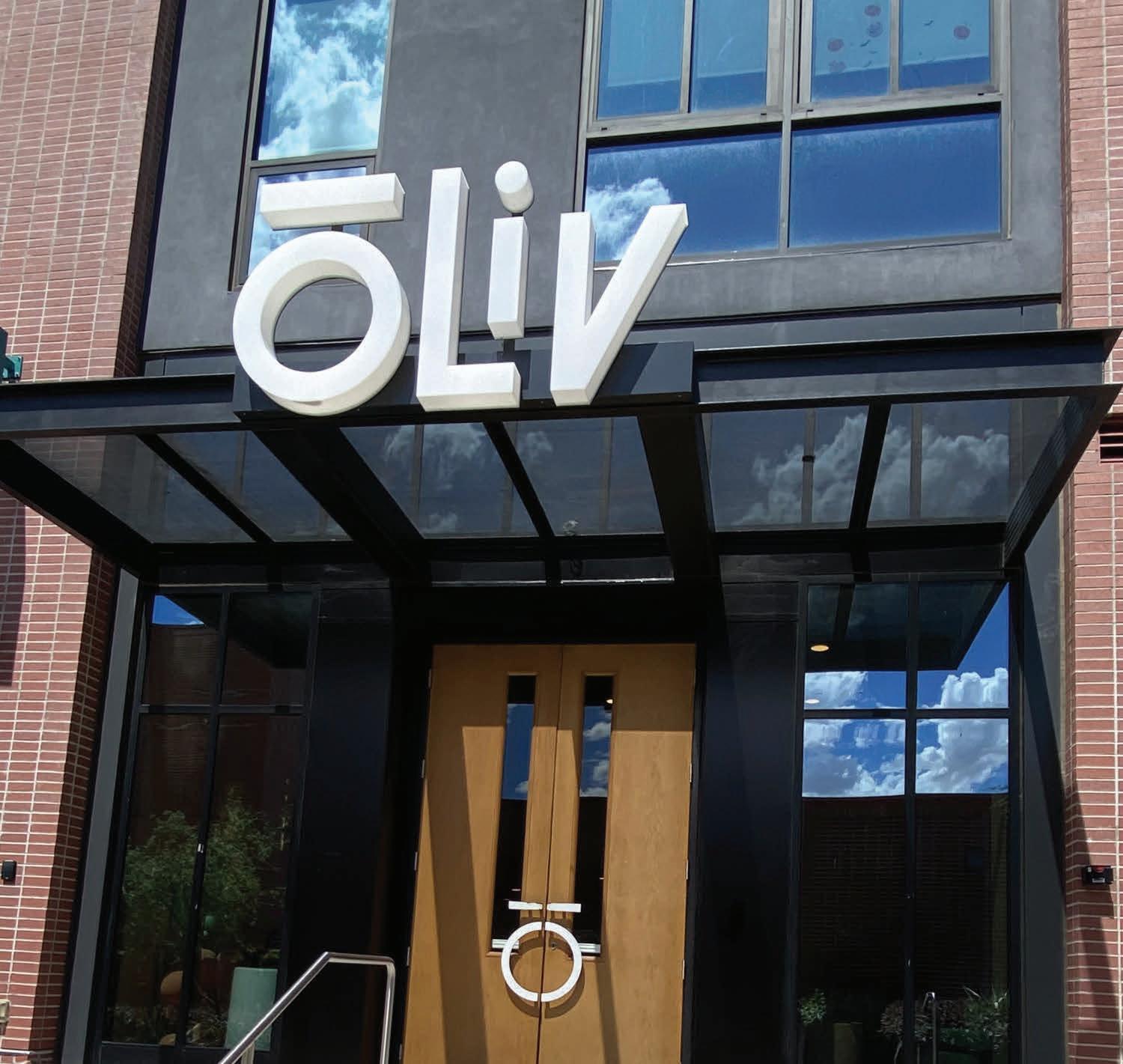
To live a reasonable distance from campus, or to live on campus, students are at the hands of the current skyrocketing prices the nation is facing.
For students funding their own education, this is a big issue.
An interesting caveat of student housing is that of Resident Assistants. RAs get to live on
campus for free, so long as they complete their training, work their hours and fulfill their duties. While on a surface level this seems like a great gig, there are a few other factors to consider here.
There is a non-traditional paycheck, and in addition, RAs can only work 10 (15 with approval) hours on campus in addition to their RA job. Part of the decision to be an RA is obviously role centered, but the financial help it provides is considerable if not of equal importance.
So, students can avoid the burden of high housing costs by being an RA but then are limited in other ways; this can mean socially, monetarily and time wise.

Students are grateful for the RA role as well as the price of on-campus housing, but they wouldn’t be in a position of need if the states’ and nation’s housing
options were affordable in the first place. Essentially, because of the housing crisis, students can resort to other solutions but this would not need to be done if housing was affordable in the first place. It is like thanking a doctor for medicine if it was the doctor that made you ill to begin with.
This college campus is a version of the world students will be entering after they leave college. If an off-campus apartment is barely attainable, how is living after college going to look?
Students are vulnerable in the face of the housing crisis, and their states, cities and institutions need to step up.
For most, back to school means back to stressing like no other. There are many stress relievers, and animals have proven to be one of the most successful. At El Jefe Cat Lounge on 3025 N. Campbell Ave., students can study with a kitty by their side or even go on their off day to pet some
felines and relax.
The owner of El Jefe Cat Lounge, Tiffany Lee, opened her business in October 2019. She was inspired both by a cat cafe in Phoenix and her daughter bringing her cat with her when she moved to Tucson. She was missing her cat, so she went to a Phoenix location called La Gattara Cat Cafe a few times. She figured something similar in
Tucson would be good for the community.
Unfortunately, it has been an uphill battle since opening the cat lounge. Lee said, “It’s been a lot of work, and we barely survived through the pandemic, but Tucson has been very supportive.”
Despite her 60-70 hour work weeks, it is rewarding for her to see people having a good time and some cats finding their forever homes.
“The main reason I opened [El Jefe Cat Lounge] is because it helps with stress. Just petting or cuddling a cat can reduce anxiety and lower blood pressure,” Lee said. She also mentioned that visitors can “make new cat friends if you’re having a hard time making friends on campus.”
Customer Claire Alexander said, “It’s a really quiet place that you can get a lot of school work done at. It’s definitely more peaceful than an average
coffee shop.”
“The cats are very nice, and their presence is just better when doing school work,” customer Katie Cao said.
For students that live outside of dorms, adoption is also an option. Being able to interact with the cats in a semi-home environment is beneficial to seeing more of their true personalities.
“All [El Jefe] cats are negative for feline leukemia and feline immunodeficiency virus, as well as spayed or neutered,” Lee said. “You get their full personalities here for a better match.”
If adopting isn’t feasible right now, the cat lounge can help cure homesickness as well. After leaving a furry friend at home, cuddling with these cats can surely help.

First-time customer Gary Talarchek used to own cats, but they have passed away. “I came here out
of curiosity and to spend some time with cats,” Talarchek said.
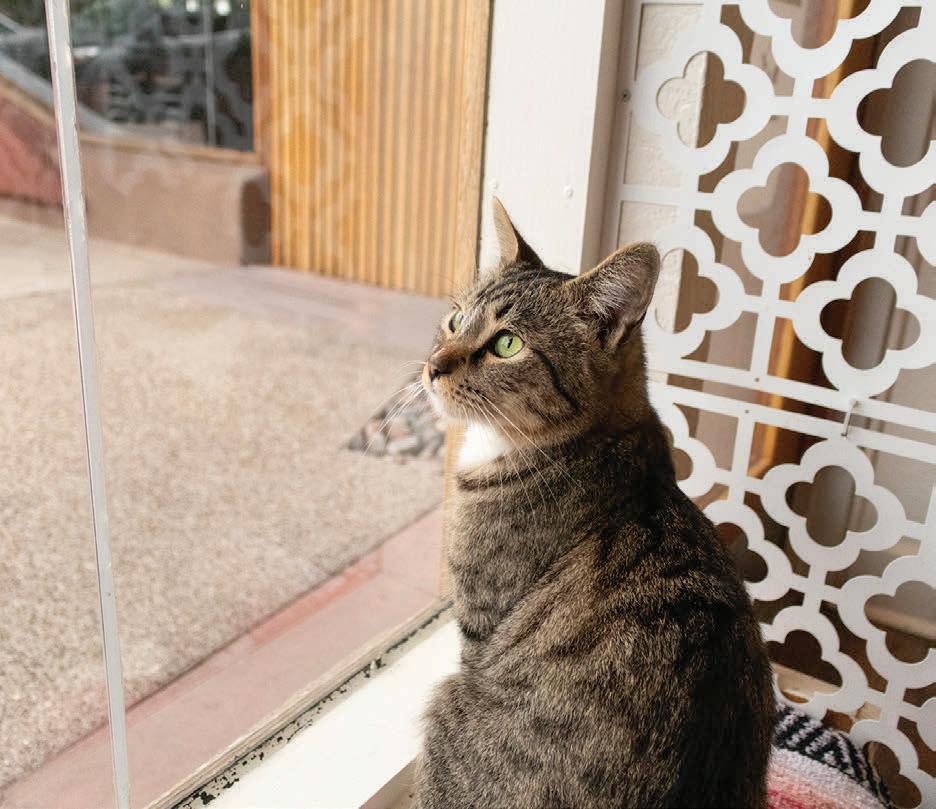
When he used to be a teacher, they would hold petting zoos for students during finals week to relieve stress.
“This is kind of similar to that,” Talarchek said.
El Jefe Cat Lounge is open from Sunday to Thursday from 10 a.m. to 7 p.m. and Friday and Saturday from 10 a.m. to 8 p.m.
More information about adopting or the cat lounge can be found on the El Jefe Cat Lounge website.
College students are notoriously busy people. Whether that be with classes, sports, clubs or Greek life, students are always on the move.
In addition to students’ campus involvements, some students may also find themselves looking for a job. the University of Arizona has plenty of job offerings to students; you just have to know where to find them.
Handshake:
Handshake is a one-stop shop for all things regarding on-campus jobs as well as offcampus jobs and internship opportunities.
Students are able to make accounts with their NetID and find hundreds of postings with filters that can help them find the perfect thing that they are looking for.


Job postings can be from Campus Recreation, the UA Bookstores, different offices and colleges across campus, etc.
LinkedIn:
LinkedIn is a way for students to make connections with peers in their field and in other majors across campus.
Students can share internship opportunities they’ve received as well as fellowships and employment opportunities. By expanding connections and networking on LinkedIn, students can get the chance to meet new friends and professional connections that can go beyond the university setting.
Instagram:
Even though it is mainly known as a social media site, Instagram is also helpful for finding on-campus job opportunities.
Various cultural centers across campus post desk job opportunities on their Instagram pages. Some specific school Instagram pages do the same when looking for student assistance.
Job Fairs:
Typically UA job fairs will host
a variety of campus professionals and local business owners looking to hire students for parttime positions.
There will also be schoolspecific job fairs throughout the year. These fairs are opportunities for students to interview with and speak with professionals in the fields they are interested in.
These three different resources are a great starting point for students new to campus looking for ways to add things to their resume as well as get some extra money in their pockets.



During a typical Tucson summer, the people are not the only grumpy ones about the weather. Even the birds cease their chirping and the lizards hide in the shade.
If you have never spent summer break in Tucson, know that each year, it is a shocking reminder that the desolate desert makes for three months of isolation and monotony.

University Boulevard turns quiet and undesirable without the bustling student life to energize it. The once traffic-ridden commute from home to campus during the school year lessens to a breezy 13-minute drive. The sun shoves everyone back inside to their couches and when thunder cracks, we take the warning from Mother Nature to stay put.
Year round, Tucson is most enjoyable downtown and across the mountains, but frolicking outdoors was the last priority during a summer of record heat and limited storms. This year, surviving the heat was no joke, with heat-related deaths amounting to 42 in Pima County throughout July. Since natural sites like Sabino Canyon and the Tucson Botanical Gardens were off limits during sunshine hours, I struggled to find delight both inside and outside of my home. There was only so much Buffalo Exchange and Bookmans to purchase before my bank statements became alarming.
Perhaps the seasonal depression went beyond just heat and (what felt like) an empty city. After spending the majority of every summer in Tucson, I noticed that
they always seem to close with a period of reflection. This year, I was especially uninspired as a local youth. I watched my peers travel overseas and to states as close as those bordering Arizona where they found opportunity and were refreshed.

Of course, that is not to say there were no opportunities on the homefront. There was an abundance of volunteer activities at sites like the Tucson Wildlife Center or Ben’s Bells. Internships were also taken up by university students at places like Pine Reads Review and Raytheon Technologies. As a native Tucsonan, I always had trouble viewing my hometown as a plentiful realm of opportunity. In fact, I saw it as the opposite. It wasn’t small enough to be a ghost
town, but it was not quite big enough for young people to pursue whatever interested them, either. The fact that some of my peers actually stayed in Tucson for such opportunities made me feel worse about my summer and my own pessimistic mindset. In my head, I was trailing everyone else because I not only lacked the financial security to leave for a substantial period of time, I also failed to take advantage of the chances I did have. It almost felt like a waste working an eight hour shift, coming home and taking a nap every day. My friends kindly tried to reassure me that “At least [I was] making bank,” and that their money was completely spent after this summer’s travels. But the money I was making was out of necessity and they were “broke” because
their families had funds to spare.
It was also a challenge to stay off social media in lingering moments of boredom, and it was even worse staying on. I was constantly tantalized by Italian lattes, Hawaiian beach days and gorgeous hiking adventures all over Instagram. At the same time, I knew that if I deleted the app I would feel disconnected from my peers, itching to be let in on their life updates.
I kept digging myself deeper into this hole with the depression of not having anyone around and seeing those who were around succeed. This whole time, I was sort of in denial about the fact I could have been productive right at home but felt too tired and unmotivated to do anything about it.
Before college started, my
friends and I had summers where our biggest worries were high school relationships and hectic family vacations. Now we are burdened by the whispers of our own anxieties telling us to hurry up and progress our careers. This summer, as I approached junior year, I spent several months worried that stocking shelves and sporting my customer service voice almost 40 hours a week wasn’t enough while all of my friends studied abroad or had research internships.
I had to come to terms with the fact that productivity is expensive, and I can’t exactly help my lack of experience. We are all part of a spectrum; college students are trickling into their financial independence and some of us have more to fall back on than others. As much as I can try to find free, rewarding activities to occupy my time, I cannot yet afford to fulfill the dream of traveling to distant lands. For now, I have to stick to what is in my reach and be less hesitant to take on smaller-scale projects. Even though my studies have not taken me abroad, they are still applicable beyond my hometown and I am still able to expand my cultural horizons through local experience.
Ultimately, summer break may feel like it’s dragging in the moment, but it is only a few months of a lifetime we have to “figure things out.” Maybe some rest and contemplation are not so bad when the distractions of due dates are at a minimum. This depression was seasonal after all, and it might have been the realization I needed to start the fall semester strong.

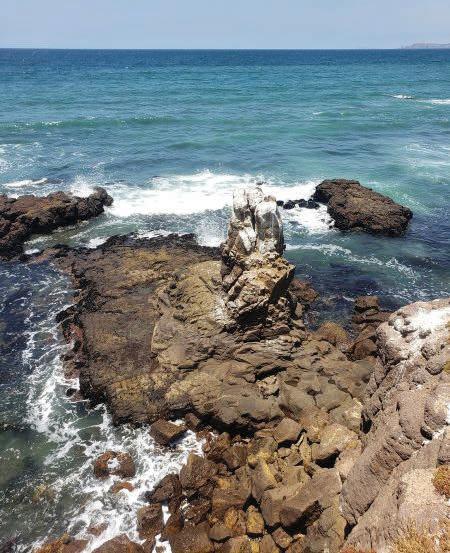





The Daily Wildcat photographers spent their summers doing all kinds of fun and amazing things. Check out these photos from Jackie Cabrera, one of our senior photographers.
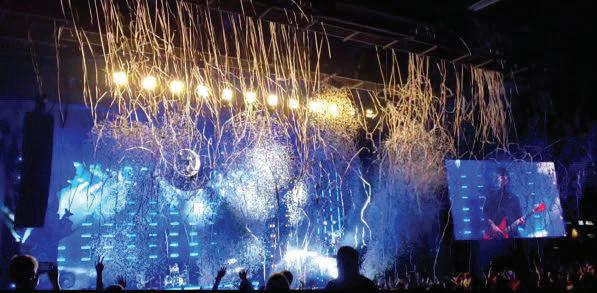




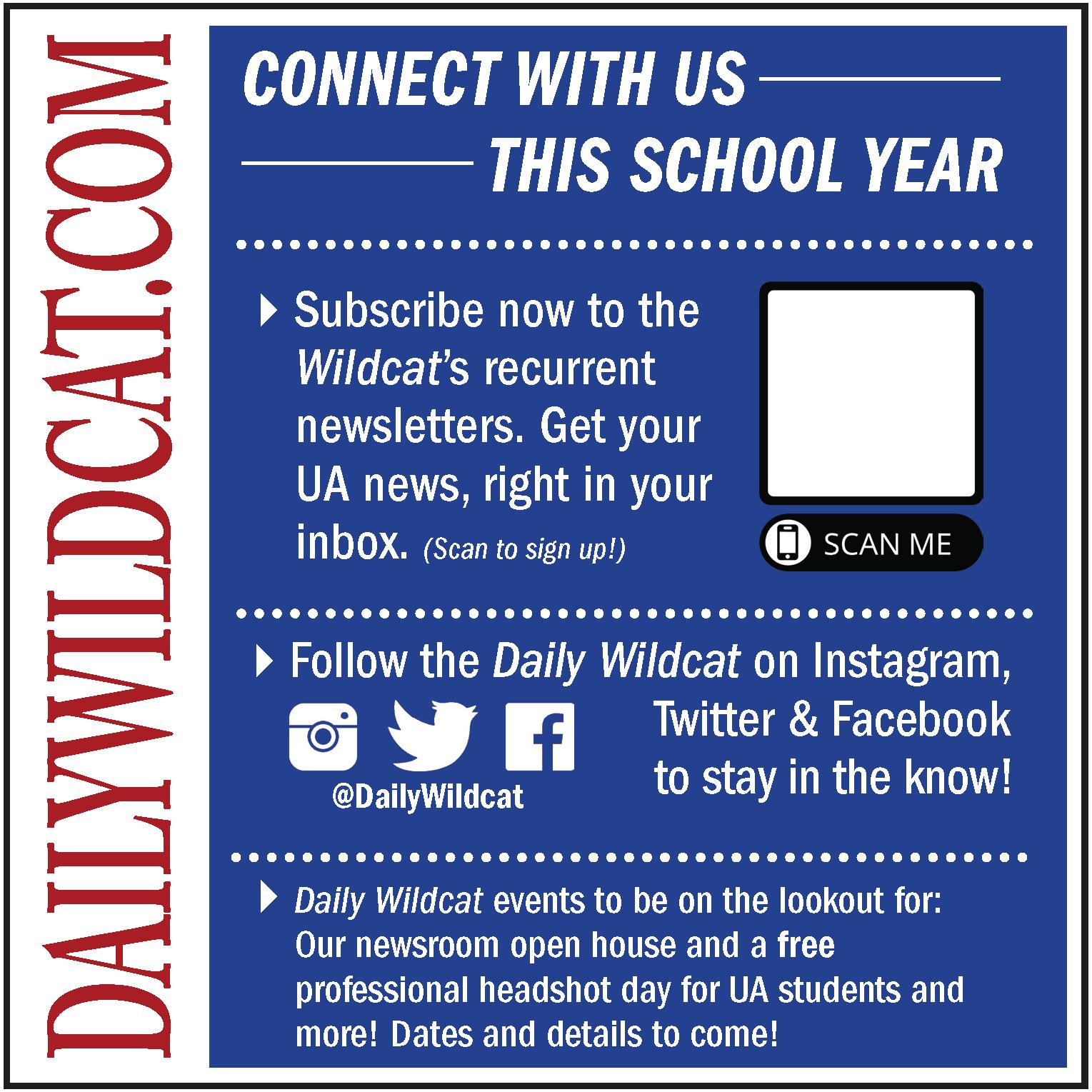

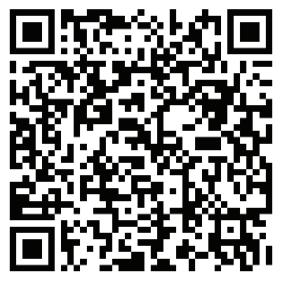
The University of Arizona and NASA’s Johnson Space Center recently signed a Space Act Agreement together which formalized a relationship between the two. This will open up opportunities for research groups across various departments at the UA for human spaceflight related research.
In 1960, the Lunar and Planetary Laboratory was founded to help support the United States’ mission to land a person on the moon. The UA played an important role in preparing NASA for human spaceflight, including helping to train astronauts and creating the most accurate lunar atlases at the time to select optimal landing sites and exploration paths.

The Space Act Agreement marks a return to that mission of supporting human space flight. With the Johnson Space Center partnership, there will be more support for researchers at the UA to pursue human space flight related projects.
The Space Analog for the Moon and Mars is a prime target for future collaborations with Johnson. Spearheaded by Kai Staats, research director for SAM, this world’s only operating hermetically sealed and
fully pressurized habitat could be the next training ground for astronauts headed to the moon or Mars. This enclosure — built at Biosphere 2 — could give astronauts a feel for what it would be like to stay at a permanent enclosure on the moon or Mars. Staats feels that the Space Act Agreement will open up opportunities for information dissemination and design that will advance the Mars habitat.
Along with helping train future astronauts, the UA may also play a role in training the next generation of space surgeons. The Arizona Program for Exploration Medicine and Surgery is a unique fellowship at the UA that trains procedural physicians in aerospace medicine to prepare them for deep space medicine and surgery.
“We can teach surgical or procedural physicians the fundamentals of aerospace medicine and try to get them experience at commercial space flight providers such as SpaceX, and then also get them hooked in and researching so that in the next 10 to 20 years, when people are back on the moon or in deep space flight towards Mars, we know how to take care of them,” said Eric Petersen, founding director of APEX.
Currently, APEX is most
closely partnered with the private sector but they are constantly looking for opportunities with NASA, and Dr. Petersen has a lot of ideas for research in collaboration with Johnson. He has ideas to pursue research identifying how pathology develops in spaceflight and how to develop tools and techniques given the constraints of spaceflight to prevent pathology.
Petersen presented another hypothetical project as a result of the partnership with Johnson and said that if NASA develops a test medical kit for an Artemis mission, the UA could stress test that kit by setting up a simulation of injured astronauts inside the SAM habitat.
While the SAM habitat looks to prepare astronauts for habitation on the moon or Mars, the UA Space and Terrestrial Robotic Exploration Laboratory is looking at how to set up semi-permanent structures on the moon with the use of robots.
“What we find is that the moon can be a great target for building all kinds of facilities if you want to build a next-generation space telescope, […] radio observatory or communications link,” said Jekan Thanga, head of SpaceTREx Laboratory.
One resource Thanga

is excited for, which could be provided by the Space Act Agreement, is the use of NASA’s Deep Space Network to be able to communicate with spacecraft outside of Earth’s orbit.
Though the Space Act Agreement will most directly affect researchers, it will also affect graduate and undergraduate students interested in space flight research. SpaceTREx has many projects going on with both undergraduate and graduate students involved, and the SAM project just had its first person receive their PhD while working on the project. And although APEX currently only has research fellows, they are looking for motivated graduate and undergraduate students interested in space medicine research to join their efforts.
Timothy Swindle, director of the Arizona Space Grant, is specifically excited about the implications of the Space Act Agreement
on both graduate and undergraduate students to get more involved in NASA science and engineering.
“A number of our students end up going to Johnson Space Center, so [the Space Act Agreement] is a mechanism that we can maybe [use to] get more internships and fellowships so that we can perhaps provide more of a pipeline which both [Johnson Space Center] and [the UA] would like,” said Swindle.
With a broad range of researchers across disciplines working on space projects, Erika Hamden, director of the UA Space Institute, is working to bring researchers together to foster more collaboration.
“As these things get more competitive, you have to have better science questions and better
projects that you’re working toward, so having a very broad range of people developing missions makes them better,” Hamden said.
Swindle added that “the Space Act Agreement is another way to make opportunities available and to do it in a way that more people are aware of it and take advantage of it.”
The push for human space flight at NASA with the Artemis missions and now at the UA with the Space Act Agreement indicates a new age of human space exploration.
“When I talk to people who are into space now, a lot of them were inspired by the Apollo missions. Who are the people that are going to be inspired by these space missions and what are they going to do 20 years in the future?” Hamden said.

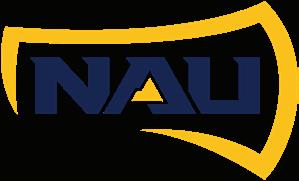
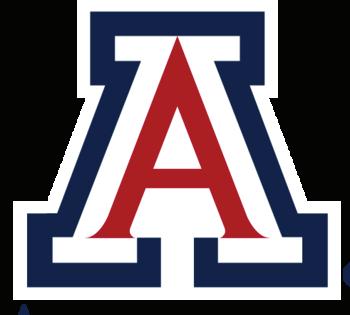








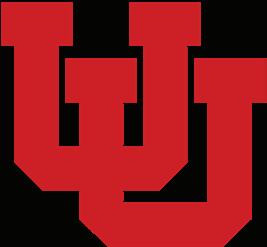
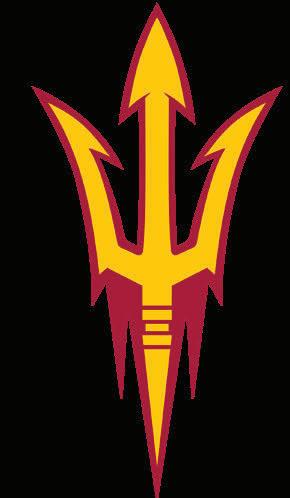










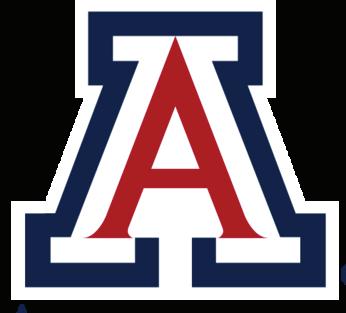
Jedd Fisch is in his third year as head coach of the Arizona football team and has kept a remarkably consistent coaching staff. He retained offensive coordinator Brennan Carroll — yes, the son of Seattle Seahawks head coach Pete Carroll — and passing game coordinator and quarterbacks coach Jimmie Dougherty for all three seasons. Fisch has expanded the staff while retaining key contributors like Jordan Paopao (tight ends), Scottie Graham (running backs), Kevin Cummings (wide receivers), Ricky Hunley (defensive line) and Chuck Cecil (defensive backs).
The only major shakeup was the loss of former defensive coordinator Don Brown after the 2021 season. Current defensive coordinator Johnny Nansen succeeded him before the start of the 2022 season, vacating his position at UCLA. The defense showed regression from 2021, but another year in Nansen’s system could allow for players to establish a more robust identity.
With stability and culture at the forefront, there are a number of storylines to track for the upcoming 2023 season.
With how quickly he took over the locker room as a leader and impact player, it’s hard to believe that last season was just Jayden de Laura’s first as the Wildcats’ signal caller. After spending the 2020 and ‘21 seasons with Washington State University, he entered the transfer portal ahead of the 2022 season. Though his off-field choices have caused scrutiny into his character
— and justifiably so — he remains a dynamic football player that has not yet hit his developmental ceiling.
The 2021 season saw four quarterbacks appear in two or more games and combined for 12 touchdowns, 18 interceptions and just a single win. De Laura’s arrival brought about a tone shift. In 2022, the only other quarterback to see any snaps was Noah Fifita, who attempted just 19 passes. De Laura threw all but one of the team’s 26 touchdown passes, scored four rushing touchdowns and contributed 435 of the 459 pass attempts (94.7%) thrown on the season. He alone threw for more yards (3,685) than the entirety of the 2021 quarterback room (2,716).
The two years following former starter Khalil Tate Jr.’s departure were rocky, but de Laura has brought much-needed stability to the most important position on the football field. It’s not hard to imagine him throwing for nearly 4,000 yards in the upcoming season.

Fisch has two full recruiting classes under his belt, and the young talents have been quick to make an early impact on the field.
The premier young gun on the Wildcats’ roster right now is sophomore wide receiver Tetairoa McMillan who, before the commitment of defensive end Elijah Rushing, was the highestgraded prospect to ever sign with the Wildcats. With the departure of Dorian Singer, last season’s leading receiver, to USC, there is an opening at the second wide receiver spot. The former four-star
prospect led the Wildcats with 8 receiving touchdowns and 18 yards per catch in his first year. He finished the season with 702 receiving yards — third-most on the team.
Sophomore linebacker Jacob Manu appeared in all 12 games in his rookie campaign, posting 27 solo tackles and another 27 combined tackles — second among linebackers in each category. He also recorded four tackles for a loss, two quarterback hits, a sack and two pass breakups. His pairing with incoming transfer Justin Flowe will pack a dynamic punch in the middle of the field for the new-look Wildcat defense. Some other notable names that are still underclassmen are right tackle Jonah Savaiinaea (sophomore), left guard Wendell Moe (redshirt freshman), Flowe (redshirt sophomore), free safety Isaiah Taylor (redshirt sophomore) and wide receiver Malachi Riley (true freshmen).
Upward trajectory
After winning just one game over the course of the 2020 and 21 seasons, the Wildcats posted a 5-7 record in 2022. With improved chemistry on the field, it’s not hard to imagine Arizona gracing the field for a bowl game come December.
Powerhouse football programs such as Ball State University, the University of Ohio — no, not Ohio State University — and the University of Nevada, Reno have all seen bowl game wins in Arizona Stadium since 2018. Meanwhile, the Wildcats haven’t even appeared in a bowl game since December 29, 2017, where they were handed a 38-35 loss by Purdue University in the Foster
There are 39 bowl games to be played for the 2023 season for a total of 78 teams that will play. To be bowl-eligible, a team needs to have at least seven wins on the season. It’s a long shot to think the Wildcats have a chance at any of the New Year’s Six (Peach, Fiesta, Cotton, Sugar, Orange and Rose) Bowls, but securing two more wins than last season is entirely within reason. The Wildcats could make one of the five other (Alamo, Holiday, Las Vegas, Sun and Jimmy Kimmel LA) Bowls with guaranteed Pac-12 tie-ins.
The Arizona football team opens their regular season against NAU on Saturday, Sept. 2, at Arizona Stadium at 7 p.m. So long as things don’t shake out the same way they did in 2021, the Wildcats will be starting the season 1-0 before they face their real gauntlet.
The week after the season opener will see the Wildcats travel down to Starkville, Mississippi, to play against Mississippi State University and complete the home-and-home. Will Rogers, the returning quarterback for the Bulldogs, is a gunslinger who landed in the top-10 for passing yards last season with 3,974. Rogers is undoubtedly one of the best quarterbacks in SEC history, and last season’s matchup saw him throw for over 300 yards and 4 touchdowns in a 39-17 win. The final score doesn’t tell the full story, though: it was a single-score game entering the fourth quarter, with the Wildcats being down 25-17 before allowing two more touchdowns. If the Wildcats are able to stun the Bulldogs and start the season 2-0, there’s little that
Arizona and Fisch couldn’t get done this season.
In the last year of the existence of the Pac-12, as we know it today, there are some dynamite matchups on the schedule as well.
The ever-formidable ASU, reigning Pac-12 champion, University of Utah, a reloaded Colorado squad led by new head coach Deion Sanders and three Big Ten-bound schools — the University of Washington, USC and UCLA — all grace the schedule this season. In years past, these would all be write-in losses. However, another year of continued retooling means that Arizona could even give the Los Angeles-based schools and Utah a run for their money.
The week three matchup against the University of Texas at El Paso will be interesting as well. The program that molded Jacob Cowing into a 1,000-yard receiver is coming to Tucson. Cowing, a native of Maricopa, Arizona, spent his first three seasons with the Miners. He exploded onto the scene in 2021 with 1,354 receiving yards and 7 touchdowns, nearly doubling the next-closest receiver on the team in both categories. He continued on his tear by posting 1,054 yards and another 7 touchdowns in his homecoming season while leading the Pac-12 in receptions with 85.
With at least three games that can preemptively be written in pencil as wins, the Wildcats’ first three games will dictate the possibility of a bowl game appearance at the conclusion of the 2022 season. Scrounging together another four wins poses to be difficult, but the Wildcats are not strangers to adversity and will look to rise to the occasion.
my situation, but people always press for more details.
BY KATE HERRERAS-ZINMAN @DailyWildcatFor some of us, the very common “What year are you?” isn’t an easy question to answer, but it’s what we hear all the time around campus, particularly when meeting new people. For example, I’m in my fifth year at the University of Arizona, but I’ve only achieved sophomore credit. I usually joke to people that I’m either a senior or a sophomore depending on what they want me to be. It’s a joke I’ve made a lot to help explain
During my first two years, I suffered from anxiety and depression that went largely untreated, and I was still in the closet as transgender. I dropped out several times, always coming back the next semester to try again and hope things would be better — which often took a long time.

This different college experience has led me to not think of college in terms of traditional class standings. Instead, to me, I’m an undergraduate working at credits towards my degree. Socially, however, that’s not an acceptable answer to “What year are you?” If you were to
say “I’m an undergrad,” people would act like you’re dodging the question. For whatever reason, people want to classify you. It’s somehow better for them if you’re a freshman or sophomore as opposed to “an undergrad.”
I’m not the only person in my abnormal situation. I know several others who have needed extra years to earn a bachelor’s degree. I’ve also heard their complicated answers to “What year are you?” — answers that make me think that we don’t need to ask that question at all.
It’s time to ditch that question. When you meet somebody else on campus, in a club or in class, you don’t need to know what year they
 BY TAYLOR DYKSTRA UA journalism student
BY TAYLOR DYKSTRA UA journalism student
The University of Arizona’s Fitness & Wellness program offers affordable fitness passes for students and locals to encourage participation in classes that will push your endurance, strength and flexibility.
The fitness pass has been around for several years and allows students to attend yoga, dance, cycling and F45 classes.
“Our goal and our mission within the Fitness & Wellness program here at Campus Rec is to try to increase the overall wellbeing for not just UAZ students, but the UAZ community,” said Jake Minnis, assistant director of Fitness & Wellness.
Passes are $50 for students, $80 for recreation members and $5 for non-members per
semester. Additionally, one-day passes can be purchased for $11. The money generates revenue for campus recreation and pays class instructors.
“The price that you find on the group fitness pass is going to be the best price in town for what we offer,” Minnis said. “You won’t be able to find anywhere else with the quality of classes and our instructors as well as the different formats for the same price or even close to it.”
Classes are offered at the university’s three different recreation centers: SouthREC, NorthREC and BearDownREC. Class types include Cardio & Dance, Cardio & Strength, Mind/ Body, Cycling and HIIT.
A fitness pass can be purchased on the UA Campus Recreation website or at the front desk of any of the three campus
are because all of the years are kind of the same; we’re all just getting closer to graduation no matter how long that takes us, regardless of if we’re in our first semester, our third, or our eighth. All of us are working towards the same goal of graduating and going on to careers.
I ask that the next time you think to ask somebody their class standing, ask why you want to know, especially if it’s one of the first things you’re asking about them. I believe the answer is always to the aforementioned classification. I argue that classification has outlived its purpose. If a freshman is new to campus and thinks they need your help with
something, it’s entirely possible that they’ll ask for your help — I imagine many of us have been in the position where a new student has asked for some backup.
That being said, the question comes off as invasive and presumptuous. If somebody wants you to know their class standing, they’ll offer that information up. That question carries more baggage for some people than others, yet we still use it as casually as “What’s your major?” or “How are you today?” and it’s time to retire the question.
— Kate, student at the University of Arizona, loves improv comedy and comic books.
recreation facilities.
Pre-registration for classes can be completed 24 hours in advance through the IMLeagues app or website and is recommended for all classes. Anyone can register for a class on IMLeagues, however, they will not be allowed into class if they have not purchased a fitness pass. Individuals must show up 5-10 minutes prior to the start of class to secure their spot. Up to 5 minutes before class begins, walk-ins are welcomed.
University of Arizona student Natalya Wells said she doesn’t mind paying for the fitness pass in addition to paying for the recreation center student fee.
“In my opinion, the pass is so worth it,” Wells said. “I don’t mind paying an additional $45 dollars a semester to get unlimited classes. If you went
anywhere else for the same thing, you would be paying over $100. I think the pass really is a bang for your buck.”
The Fitness & Wellness program at Campus Recreation is looking to introduce more Pilates and resistance based training classes. They are also looking to start up a kickboxing class in the near future.
“My favorite class types would probably have to be the
F45 and cycling classes, but I really want to try other classes, such as Zumba and Pilates,” said Samantha Anger, a student fitness pass user. “The only thing is that I wish they would add more class times.”
The group fitness class schedule and upcoming Fitness & Wellness announcements can also be found on the UA Campus Recreation website at rec. arizona.edu.

Studying abroad may feel overwhelming for freshmen who are already being flooded with change. However, other Wildcats stress how this should not mean that the opportunity should fly under one’s radar. Here are a few tips for those on the fence about studying abroad.
Tip 1: Decide where to travel
The University of Arizona has study abroad programs in various regions, including but not limited to London, Sydney, Costa Rica and Barcelona. However, checking in with academic advisors is essential to ensure the program is compatible with one’s degree.
Daryl Ijaola, a biochemical engineering major, studied abroad in Alcalá de Henares, Spain, for four weeks over the summer.
“I have already convinced, I think, two or three people to go on the trip next year, and we just got back. I talked to somebody who went before me recently, but if I had talked to them beforehand, they would have convinced me to go. Talk to people and research the city,” Ijaola said.
Hannah Lichtenwalter, a double Africana studies and Spanish major, earned credits toward her degree in Spain.
“Look into the culture and traditions of the region, their daily life, [be] respectful and study the basics of the language so you can connect with locals more. Also, mentally prepare for the immersion,” Lichtenwalter said. “People should consider places they might not [have] immediately. Spain was not the first place I would have studied abroad, but I ended up having a really good experience there.”
Tip 2: Understand the process, be prepared
Once one has selected a destination, they must fill out an online application on the University of Arizona Study Abroad website for the specific area they are interested in. It is here students decide when and how long they wish to study abroad and get an estimated cost for the trip. Study abroad programs can be during the fall, spring or summer.
Abigail Sotelo, a director for the University of Arizona Alcalá de Henares Summer 2023 program, stressed the importance of having one’s U.S. passport ready as early as possible.
Sotelo explained that, ideally, the process for applying for a U.S. passport should begin alongside the application to the program itself, allowing wiggle room for any COVID-19 delays.
“The Alcalá program requires the U.S. passport [to be] ready before the trip because in areas like Seville, Granada and Córdoba, a passport number is needed when buying tickets. Since we do not have an ID from Spain, they need an identification number, and the only number we have is the American passport number,” Sotelo said.
Once the application is accepted, one will be prompted to commit to the program by a specific date and submit the necessary documentation. It is crucial to mark important deadlines on one’s calendar to make the process as efficient as possible.
There will also be a pre departure orientation course to complete before the start of the program. This course provides student support services, such as counseling and psychological services for those experiencing homesickness. It will also go into detail on the GeoBlue international emergency medical insurance.
“The medical insurance and medical attention in Alcalá was very good and quick. When one of my students got sick, we waited around 20 minutes to receive medical attention. In total, it cost around 25 euros for all the medication, which was not covered by the insurance but was still very cheap. There was also no co-payment or need to make an appointment,” Sotelo said.
Ijaola had some extra tips to share to make one’s visit as comfortable as possible.
“Overpack. I love to overpack because I hate being unprepared. For example, I forgot to pack my shorts and forgot how hard it is to find some. Prepare a budget for yourself and, if you can, save up too much money. As in, I’d rather have too much and have a lot of freedom spending than not [have] enough and [be] stuck in one place,” Ijaola said.
Lichtenwalter shared some advice based on her experience in the study abroad program.
“I would recommend looking into the details of the program, [like] if it’s a homestay or if you will be in a dorm. Just consider the level of independence that you want, the length of the program and the culture, because there can definitely be a big culture shock in certain parts of the world. Even in Spain, there were parts that were a lot different and that I enjoyed, but maybe not everyone would,” Lichtenwalter said.

“I think the cost is worth it, but I also think it is important students apply for scholarships. There have been years where money is left over because not enough students apply. It is important to apply and have a very strong recommendation letter ready,” Sotelo said.
When asking for a letter of recommendation, Sotelo advises asking a professor with plenty of time to ensure the letter is quality and not rushed.
For Lichtenwalter, a scholarship made all the difference.
“Applying for scholarships, I got one through the W.A. Franke Honors College. That played a big role in my decision to study abroad,” Lichtenwalter said.

While traveling abroad can get expensive, Ijaola remained confident it was worth it, “Especially with the scholarship that lowered it down. The food you get, experiences you get,
going to different cities every week. I thought I was going to stay in one city, that is how much I paid for, but you are paying for so much more,” Ijaola said.
In areas like Europe, where pickpockets may be a concern, it is crucial to remain hyper-aware of one’s surroundings and belongings.
“You have to use common sense, always. Do not walk around alone at night; you should not do that anywhere. Even if the area is very safe, one must always use common sense,” Sotelo said. “If they are nervous about being robbed, I would suggest keeping your backpack on your front side. [Keep] wallets in the pockets on the front or simply [use] a fanny pack.”
While remaining precautious is essential, one should keep an open mind about their surroundings.
“It is a life-changing experience. It changes your perspective on how you view the world,” Sotelo said.

Galleries, restaurants and familyowned stores surround the University of Arizona. If you are new to Tucson, here are three destinations you would not want to miss.
Music isn’t a product, it’s a passion for this local Tucson record store. Located on 636 N. 4th Ave, Hurricane Records has been serving the Tucson music junkies for six years. All genres of vintage and new records are sold here.
Hurricane Records first started as
a vintage record store but now sells a variety of new records.

Employee Ted Riviera, 55, said some of the most popular genres include reggae, hip-hop, punk rock and 90s alternative.
Popular artists include Lana Del Rey, Fleetwood Mac, Frank Ocean and the Red Hot Chili Peppers.
“The owner [Rich Hopkins] has a UK distributor for the Frank Ocean records because it is almost impossible to get them domestically,” Riviera said.
The Book Stop, located at 214 N. Fourth Ave., exclusively carries used books with almost any genre you can think of.

Every book on the shop’s shelves has been brought in by people who donate or who want to trade in their books for other titles.
In addition to books, they carry a wide selection of vintage art, random vintage material, postcards, maps and photos.
Avery Lane, 32, has officially been working at the Book Stop for two years but has been helping out for years.
Literature, history, art, photography, local Arizona history and cook books tend to be the books people gravitate towards, Lane said.
You won’t need your passport for
this Mexican trip. La Iguana Art Gallery owners Imelda and Mario Jiménez have been sharing their culture through art for 16 years.
Located at 545 N. Forth Avenue, the shop is covered in crosses, Virgin Mary statues, catrinas, pottery, jewelry and handmade dolls from all across Mexico.
La Iguana caters to every age group. The miniature cartoon character Catrinas seem to be very popular with kids, Imelda Jiménez said.
“It is beautiful to share my culture and for others to recognize it,” Imelda Jiménez said.


12 oz cans.
BY KELLY MARRY @DailyWildcatEnergy drinks have rapidly become more prevalent on college campuses. Since most students don’t get enough sleep, energy drinks offer consumers more caffeine so they can stay awake longer and be more alert. However, consistently drinking them can be extremely harmful.
The Centers for Disease Control and Prevention define an energy drink as “a beverage that typically contains large amounts of caffeine, added sugars, other additives, and legal stimulants such as guarana, taurine, and L-carnitine.” In 1997, Red Bull was introduced to the U.S., and since then, hundreds of other brands have been created and their primary market is college students.
Energy drinks are not regulated as food but as supplements, so manufacturers can add more caffeine. The Food and Drug Administration says 400mg of caffeine is the maximum amount a person should have daily without adverse health effects. But this is only for adults in pristine health and only for an occasional drink, not relying on them to make it through the day.
For context, a standard 12 oz can of Red Bull has about 114 mg., and a 16 oz can of green Monster has 160 mg. The energy drinks marketed as “healthy,” like Celcius and Alani Nu, have 200mg in their

The obsession with these drinks is prevalent throughout campus. I don’t think there’s been a day where I don’t see multiple people drinking them. All markets on campus sell them, and I have seen people giving them out at the UA Mall for free.
Not only do energy drinks have a lot of caffeine, but their other ingredients are also unhealthy. They have a massive amount of sugar, and the American Heart Association recommends 36g of sugar for men and 25g for women. A standard Red Bull has about 38g, a green Monster has 54g, and Celsius and Alani Nu drinks are “sugar-free” but contain sucralose, an artificial sweetener.
Another thing taking over college campuses is the use of pre-workout.
Like energy drinks, pre-workout offer a boost of energy to complete a workout. Most pre-workouts have the same ingredients as energy drinks, but some contain steroids banned by the NCAA. Most people don’t need pre-workout because they can receive energy from a balanced diet.
Energy drinks should not be mixed with alcohol. Since energy drinks have loads of caffeine, they can conceal the depressive effects of alcohol, causing the consumer not to realize how much they have had until it’s too late. Four Lokos were banned because they contained three stimulants, caffeine, taurine and guarana, and one depressant – alcohol, and they have since been rebranded only to contain caffeine and alcohol.
Drinking many energy drinks per week can have awful side effects, especially on your heart. They can cause heart palpitations, heart rhythm malfunctions and increased blood pressure and heart rate.
If minors drink energy drinks, there are even more ramifications, like insomnia, stunted growth and cardiovascular anomalies.
Most energy drink companies have warnings on their websites saying their products are not recommended for children, but studies have shown that 67% of adolescents have consumed energy drinks.
There are many other healthier ways to get caffeine, like green tea, black coffee and dark chocolate. I have fallen victim to consuming
energy drinks a lot, especially during finals, to get an extra boost, but I try to stop myself because I have been addicted to them. They offer a temporary boost but can have lasting effects.


The University of Arizona has a historic sports landscape that’s vital for incoming Wildcats to be aware of. Many former Wildcats land in the big leagues, so take a sneak peak into some of Arizona’s top athletes.
Men’s basketball:
Oumar Ballo - Center - Redshirt junior - Koulikoro, Mali
Ballo is a player who has carved out an important presence on the basketball court after transferring in from Gonzaga University before the 2021-22 season, following current head coach Tommy Lloyd. His journey from Mali to the UA reflects both his ambition and athletic prowess.
Ballo’s evolution into a dominant force in the paint is evident. His impact has been recognized over the last two seasons, earning Pac-12 Sixth Man of the Year recognition in 2021-22 and Pac-12 Most
Improved Player of the Year and First Team
All Pac-12 honors last season.
As he enters the season looking to build on an impressive 2022-23 campaign, his towering presence, lightning reflexes and leadership promise an impactful season. He will be a key contributor in the Arizona men’s basketball team’s pursuit of greatness and their ultimate goal of winning a national championship.
Caleb Love - Senior - Guard - St. Louis
Love, a seasoned senior guard for the Wildcats, brings a wealth of experience and accomplishments from his time at the University of North Carolina at Chapel Hill. During his tenure there, Love emerged as a dominant force, securing honors like All-ACC honorable mention in 2022 and 2023 and a spot on the ACC All-Freshman team in 2021. After briefly committing to the University of Michigan, he ultimately landed in the desert less than two months later via the transfer portal.
Love’s impact is underscored by his statistics. With a remarkable 1,476 points

and 200 3-pointers, he showcased his dynamic offensive prowess and range. Renowned for strategic decision-making and adept passing, he totaled 338 assists over three seasons in Chapel Hill, averaging 3.3 assists per game.
As he enters his senior year, Love’s experience and skills promise to elevate the Wildcats’ game. His ability to read the game and orchestrate plays positions him as a pivotal asset in Arizona’s 2023-24 plans.

Esmery Martinez - Forward - Fifthyear senior - Hato Mayor Del Ray, Dominican Republic
Martinez is a towering figure in women’s basketball standing at 6-foot-2. Her journey to Arizona parallels other notable Wildcats: she transferred in from West Virginia University before the 2022-23 season.
On the court in Wildcat colors, she has showcased precision scoring and plentiful rebounding – she posted 274 rebounds last season, eighth-most in a season in program history. Her consistent excellence, marked by double-doubles, all-conference second teams and honorable mentions over the last three seasons, is a vital presence in a locker room that has seen so much turnover since the end of last season.
In her final year of eligibility, her influence is poised to peak. Only one other key starter from last season is returning, so she will step into the position as a vocal veteran leader. Martinez will continue paving her way to the pros – she declared for the 2023 WNBA draft but decided she had unfinished business with Arizona and will grace the courts in McKale Center for one final season.
Helena Pueyo - Guard - Fifth-year senior - Palma de Mallorca, Spain
Pueyo is a basketball powerhouse, leaving a wake of excellence from the Spanish National Team to Arizona. She’s graced the Wildcats’ court with defensive prowess for the entirety of her five-year collegiate career. Transitioning from international play to Arizona, Pueyo’s skill development shines brightest. She was a Pac-12 All Freshman honorable mention in 2020 and a Pac-12 All Defensive Team
honorable mention in 2021 before fully making the Pac-12 All-Defensive Team in 2022. Her impact, much like Martinez’, is poised to peak, with her defensive finesse and leadership becoming defining elements in a very young locker room.
Jayden de Laura - QuarterbackJunior - Honolulu
De Laura, the starting quarterback at Arizona, boasts an interesting football journey. His potential was spotlighted by his accolades as the 2021 Pac-12 Offensive Freshman of the Year with Washington State University before transferring to Arizona.
De Laura’s arrival immediately impacted the team and elevated the passing attack. His 3,685 yards and 25 touchdowns in a single season are third and sixth most in program history, respectively. His adaptability and leadership as a versatile quarterback continue to flourish on the field. He has lifted the offense up around him and provided a spark to a unit that was pedestrian in the years since former starter Khalil Tate Jr. left for the NFL.
Beyond his impressive statistics, de Laura’s leadership qualities have made a mark on the team. With each snap, his poised demeanor under pressure shines, solidifying his role as a driving force in the Wildcats’ pursuit of success. As football season approaches, de Laura will look to build on last season and cement himself as a Wildcat name to remember.
Continued on Page 28
Continued from page 27
Cowing is a wide receiver with a dynamic presence on the football field whose journey to Arizona is marked by growth and excellence. Cowing made an immediate impact upon joining the Wildcats after three seasons with the University of Texas at El Paso. He’s demonstrated an ability to make crucial catches and evade defenders while solidifying his role as a go-to receiver for de Laura.
Throughout his collegiate career, he has showcased major growth in his production and an improved understanding of the game’s nuances. He burst onto the scene in his junior year with 1,354 yards and 7 touchdowns. He continued that production last season – his first with Arizona – with 1,034 yards and 7 touchdowns. All eyes are on his connection with de Laura as the Wildcats strive to keep their upward trajectory.
Corona took the long road to the UA, a path that led him through the University of Washington and then Pima Community College, where he honed his skills and showcased his potential.

On the field, Corona displays an ability to read pitches, connect with the ball and
create scoring opportunities, all while maintaining consistent offensive output and a commanding defensive presence in the outfield. He was one of six Wildcats last season with double-digit home runs and he batted .369 on offense. On defense, he was responsible for 43 putouts and only tallied a single error. Corona’s journey in Tucson continues to unfold and he’s poised to elevate himself even further. His seasoned skillset will mean impactful plays are to come.
White, a rising star on the Arizona baseball team and a Tucson native, seamlessly integrated his hometown roots into his sports journey. He solidified his status as a local talent to watch after being named to the Collegiate Baseball Freshman All-American team. A sophomore infielder, White’s presence has already been established. He has transformed from a local high school standout into a key player on the Wildcats’ roster.
White’s versatile skill set shines both offensively and defensively, elevating the team with his infield plays and plate contributions, while his connection to the community adds fuel to his drive to succeed on a broader stage. He posted 35 RBI and 10 home runs offensively along with 72 putouts and a .953 fielding percentage. With his journey in its early stages, Arizona is poised to benefit from his ongoing growth and development.
Skaggs has left an unforgettable mark on the Arizona softball team. From clinching the Rawlings Gold Glove Award to claiming the prestigious title of Pac-12 Defensive Player of the Year, both in 2023, Skaggs epitomizes a standard of excellence.

Skaggs brings with her an appetite for success, immediately making her presence felt through her remarkable defensive prowess and power hitting. In her junior season, she posted four grand slams and led the team with 14 home runs along with her perfect 1.000 fielding percentage.
Skaggs is a linchpin in the team’s triumphs and her game is characterized by immaculate fielding and game-altering plays. As a senior, her dual role as an onfield performer and leader will continue to
uplift the team. Skaggs is poised to guide Arizona through yet another season of high expectations.
Netz, a versatile senior, is an exceptional talent in both pitching and hitting. With an impressive 102 games under her belt, Netz’s impact is felt on the mound and at the plate. Her pitching prowess shines through her 34 wins and 235 career strikeouts, while her consistent hitting and clutch runs underscore her all-around capabilities. In her junior year, she posted a 16-16 record but 135 strikeouts and a save. As a senior leader who has spent her entire collegiate career at Arizona, Netz’s experience sets her up to guide the team on their bounceback season.
University of Arizona booklovers have a new resource on campus.
The Guerrero Student Center Library in the Cesar E. Chavez Building is now open to all students, staff and faculty members to check out books from a variety of genres for leisure reading.
The library officially opened in February with around 70 books, mainly from the personal collection of Lucero Ramirez, coordinator at the Adalberto & Ana Guerrero Student Center at the UA. The books they have now are mainly young adult fiction, with some nonfiction, romance and coming-of-age novels, according to Ramirez.
How the idea formed Ramirez, a self-proclaimed book enthusiast, had the novel idea to start a library at the center, inspired by a library she started in her classroom when she taught English at Pueblo High School.
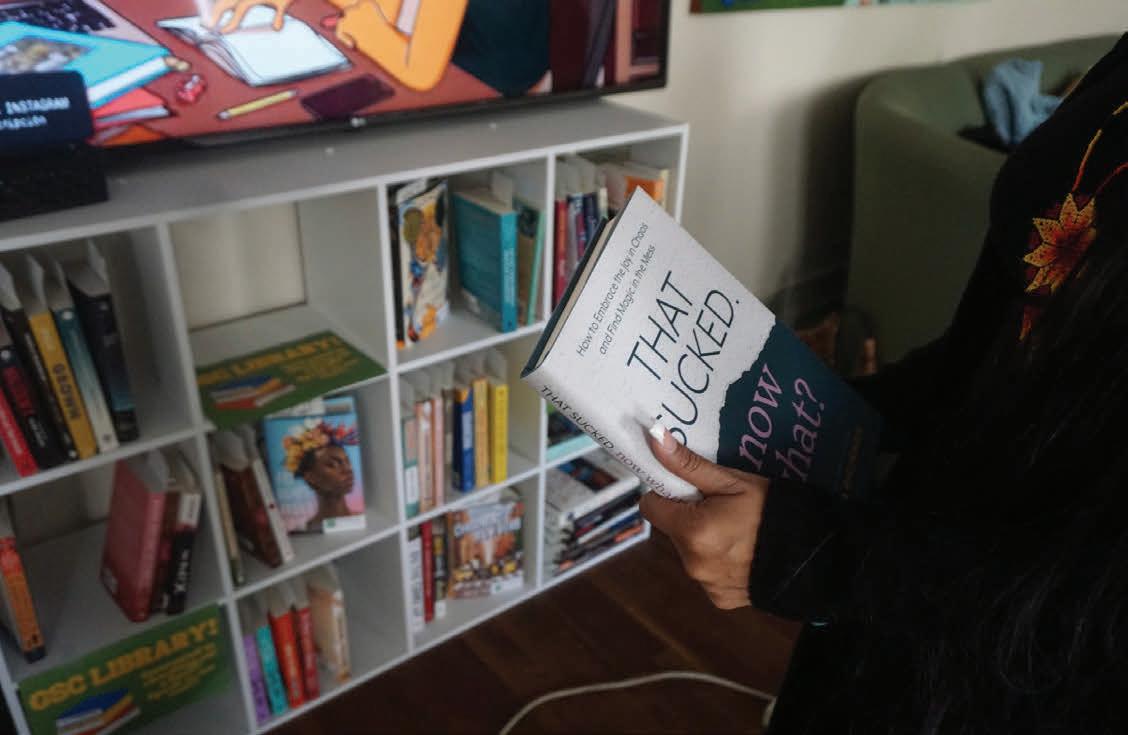
Ramirez said she wanted to
make reading more accessible for students. She said she remembered that when she was in college, she loved reading but couldn’t necessarily afford new books.
“When you’re paying for tuition and fees and whatever other supplies, books and stuff, I feel like our budgets are so tight that we can’t even splurge on a $15-$20 book,” Ramirez said. “Because it’s that versus lunch or that versus the textbook.”
From her previous position as a culturally responsive educator, her job was to be intentional about the literature that was taught. From this experience, she learned how validating it could be to read stories about people who come from similar cultural backgrounds.
According to the UA Guerrero Center’s Instagram, their mission is to “support Latine students achieve academic and personal excellence.” This influenced the book selection for the library.
Ramirez said that the majority of the books are by Latinx authors and the stories cover many intersectional identities, such as Afro-Lantix, Indigenous Latinx and
queer Latinx.
Gisselle Ramirez, graphic designer and desk assistant for the GSC, said she believes the library’s primary purpose is to provide literature to students that is culturally sensitive. Gisselle Ramirez is also Lucero Ramirez’s younger sister.
“In regular classes, usually books aren’t centered around people of color,” Gisselle Ramirez said. “So I think the purpose is [not only] to expose [students] to books about their own culture, but other people’s cultures and also queer representation, disability representation, those types of things.”
Gisselle Ramirez said checking out a book only requires leaving behind a name and contact information that is recorded by the desk assistant. She said the library averages around at least one checkout per day.
The library has a maximum of two books per person at one time, with a lending period of a month, according to Lucero Ramirez. Library patrons can renew the book after that.
One student who has used the library is Jennitza Barreras, a sophomore majoring in preelementary education. She said she noticed the workers setting up the new library one day while hanging out at the student center.
Barreras checked out “Eva Luna” by Isabel Allende. Barreras said she liked seeing the representation within the books, being MexicanAmerican.
“Growing up, I didn’t really see a lot of books that were geared towards that kind of community, even in the UA in general,” Gisselle Ramirez said. “But the Guerrero Student Center is geared towards Latino and Hispanic students and it’s kind of like a little community.”
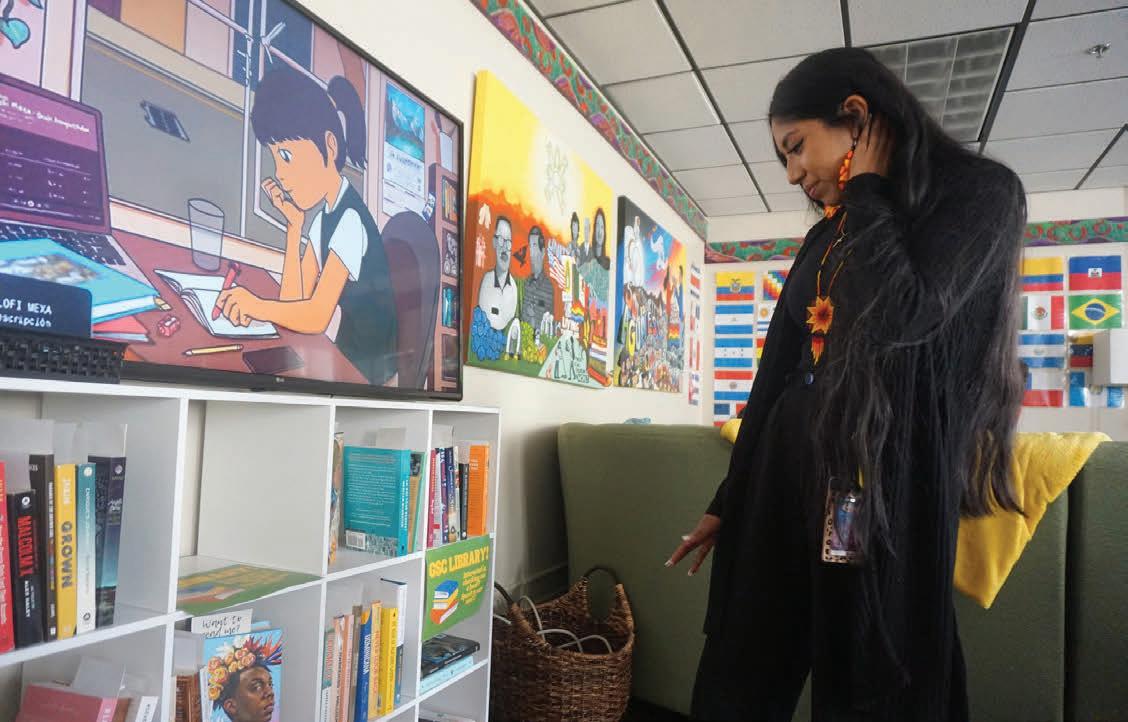
Lucero Ramirez said they are also flexible with working with patron needs and want to make the library accommodating for all.
“In a traditional library, you have to come physically into the space to check out a book, whereas in our case, someone sent us a [direct message] on Instagram that they saw a book in our story that they really wanted and if they could reserve it,” Lucero Ramirez said.
After receiving the message, the library sets it aside for the student to come in to check out the book at a time that is convenient for them.
Lucero Ramirez said the library has room to shelve 100 to 150 more books and is always accepting donations, but is mainly looking for any new or gently used books. As for genre, she said the center is “pretty open” to the book selection.
The coordinator said she’s working to expand the library by creating an online catalog of the books they have, which could remove a barrier of the time spent looking for a book in person.
“When I was in college, coming to campus was such a big
commute,” Lucero Ramirez said. “Sometimes if they are on campus only the day they have class, then maybe they can just swing by really quick.”
She said that she hopes more of the community will learn about the library and perhaps even share their own books.
“There’s so many faculty, staff and students that love reading or want to get into reading and we want to make sure that we provide the space […] and mirror the library experience,” Lucero Ramirez said.
Where: Chavez building, on the second floor
Hours: Mon-Th 8 a.m. to 6 p.m. Fri 8 a.m. to 4 p.m
Checkout process: Talk to a desk assistant who will ask for contact info
Checkout limit: Two books, with a hold period of one month

Generative artificial intelligence innovations — primarily natural language processing technologies, such as ChatGPT — are rapidly transforming the lives of college students. With AI becoming popular among students, Arthur “Barney” Maccabe, the executive director of the Institute for the Future of Data and Computing at the University of Arizona, believes it can give some people an advantage over others.
“It’s not just a disadvantage, I think we should be teaching students how to use these tools ethically and effectively,” he said.
Maccabe explained that resources like ChatGPT have risks that extend beyond mere plagiarism. Academics are now faced with complicated decisions about the role of AI in research.
BRIANNA GOLDEN | THE DAILY WILDCAT THE EXPLOSIVE POPULARITY OF artificial intelligence has led to growing conversations about how it should be used in academic spheres, if at all. While the University of Arizona does not currently have a policy on AI, individual instructors may choose to whether or not to allow students to to use it.
“Say you’ve done original research. Can you use these tools to write a paper around what the results mean and how they fit into the world?” Maccabe said.
Natural language processors like ChatGPT aren’t always equipped to filter out bias and


identify whether a source is credible.
“AI amplifies bias by amplifying human bias that it encounters in the data it analyzes. You’re losing the ability to evaluate the credibility of sources. How trustworthy is it? How biased is it?” Maccabe said.
Maccabe pointed out AI’s potential to disrupt the workforce on a larger scale than previous technological innovations, such as the automation of the textile industry.
“When we were able to make weaving automated, we lost weavers, but what quickly adopted was tailoring because people now had multiple sets of clothing,” Maccabe said. “But now we’re starting to automate intellectual and creative content. [...] AI will change what the creative arts look like.”
Maccabe provided the recent writer’s strike in Hollywood as an example, and said “[AI] is a reason why writers are on strike right now. It’s because of these technologies and what they are going to mean for the future.”
Maccabe expressed the opinion that the campus community is not yet equipped
to navigate the complexities and ethical implications of AI.
“We are not equipped because we’re not having the conversation,” he said.
The University of Arizona’s official website states that “[UA] does not currently have a policy on the use of ChatGPT. However, instructors may have policies on how ChatGPT may or may not be used in classroom assignments.”
The Arizona Board of Regents Policy Manual does not include policy surrounding AI technology, either.
UNESCO said “the education sector needs to make these ‘qualifying’ determinations on its own terms. It cannot rely on the corporate creators of AI to do this work.”
While Maccabe stated that the UA has employed “working groups this summer who are trying to address some of [these] issues,” it is unclear how the UA and Arizona as a whole will proceed in the policymaking process, or if instructors will be left to develop their own rules.
Despite the foggy ethical boundaries ahead, Maccabe feels that the rewards of AI technology far outweigh the risk — but only under the condition that we don’t “go into it blind without having any conversation.”

J Street U of A is a newly registered club at the University of Arizona that is all about politics and democracy.
J Street U of A is the UA chapter of J Street U. The club strives to teach students about the Israeli-Palestinian conflict and advocate for human rights, peace and democracy. The club plans to hold honest and nuanced conversations regarding the conflict and the United States’ involvement.
“We believe that it’s really important that we can provide a forum for people to just come, learn, discuss and bring ideas,” Daniel Wittenberg, the former president of J Street U of A said.
Wittenburg, sophomore, founded the UA chapter of J Street over a year ago. With the help of the officers and members, they worked hard to get J Street U of A recognized. Wittenberg said that they first registered as an official club in spring of 2022. “I’d say it took about a week to get everything together because we needed an advisor and to create a constitution,” Wittenberg said. The club has to register every April for the following school year which, from now on, will take only a few hours.
Wittenberg has recently been elected to become the West Coast vice president for J Street U nationally. He said that he’ll still be involved in the club but most of his time will be spent doing things for all West Coast chapters.
Charlie Shadid, sophomore, is stepping into Wittenberg’s position and taking over as president of J Street U of A starting this semester.
Shadid has had an interest in politics since he was in high school and knew that he wanted to get involved during his college years. He saw J Street U of A at the club fair in his freshman year and knew that was the route he wanted to take due to his background knowledge on the conflict.
He said he got involved in the club pretty quickly and soon took an officer position as secretary.
Shadid said that when he joined the club he tended to take more of a pro-Palestinian approach to the issue but after having discussions, he shifted his thinking a bit.
“It has made me understand, you can take a side that supports both. It’s not black and white,” Shadid said, “You can just support human rights and express outrage against human rights violations.”
Mayra Shoshitaishvili, sophomore, was involved in J Street U of A before she officially joined in the spring 2023 semester. She learned about the club through Wittenberg during her freshman year and connected to it on a personal level. Her family immigrated to the U.S. during World War II.
“I want to get more involved with things relating to my culture,” Shoshitaishvili said. Shoshitaishvili said that she wants to be able to help people in Palestine and Israel as an emergency medical technician.
As a ravenous media consumer, I have a passionate love for all sorts of comic books and


comic strips. Being a form of storytelling that is both visual and written, comics are obviously the superior artform. Well, even if that may be partially an exaggeration, I couldn’t be more excited about guiding along the next generation of two-dimensional scribbles that seem to carry on a life of their own.
Now as you all may be dreading the mundane routine of the semester, enjoy the not-somundane lives of lunar rangers Sylvania Spaceray and Crater the Dog in the all new comic strip “Atomic Age Adventures.”


Also, keep your eyes out for more new comic content from talented student artists here at the Daily Wildcat!

